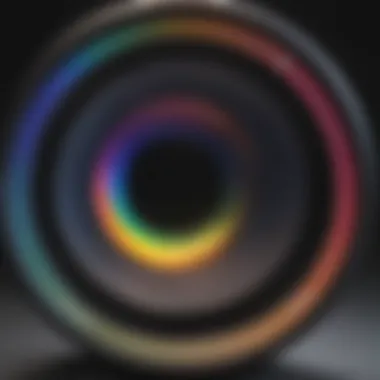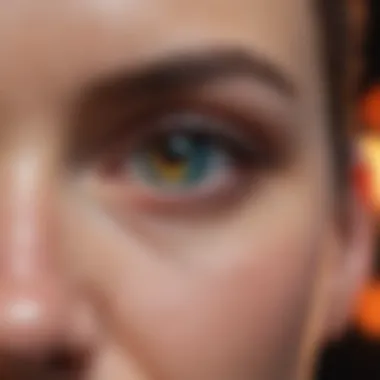Understanding Colour Vision Lenses: A Comprehensive Guide


Intro
The field of colour vision lenses represents a critical intersection between optical technology and human physiology. For individuals with colour deficiencies, everyday experiences can be significantly altered. Colour vision lenses have emerged as a potential solution for these challenges, aiming to enhance the perception of colours and improve overall visual function. Understanding the mechanisms by which these lenses operate requires an exploration of their underlying principles, technological advancements, and the personal stories of those who use them.
In this examination, we aim to offer a detailed understanding of colour vision lenses. From their scientific basis to the real-world effects on users, we will analyze various elements that contribute to their efficacy. This discussion is particularly relevant for students, researchers, and practitioners engaged in optical technologies and vision science. By integrating scientific insights with practical applications, we hope to provide clarity and depth to this evolving subject.
Research Overview
Summary of key findings
The research on colour vision lenses reveals several significant findings:
- Enhanced colour discrimination: Users often report an improved ability to differentiate between colours that were previously indistinguishable.
- Positive psychological impact: Many individuals experience increased confidence and satisfaction in their everyday life when using these lenses.
- Technological advancements: Innovations in lens design and manufacturing techniques have led to more effective solutions tailored to individual needs.
Importance of the research in its respective field
The implications of this research extend beyond the realm of optical science. By better understanding colour vision lenses, we can improve educational strategies for those affected by colour deficiencies. Moreover, insights gained from these studies may inspire further technological innovation, paving the way for new solutions that enhance quality of life. The knowledge generated by this research can aid multiple stakeholders, including educators, healthcare professionals, and optical companies, in creating targeted interventions that address the challenges faced by individuals with colour vision deficiencies.
Methodology
Description of the experimental or analytical methods used
Various methodologies were employed in studying the effectiveness of colour vision lenses. These range from controlled lab environments to real-world user trials. Common methods include assessments of colour perception accuracy using established tests, such as Ishihara plates, alongside user feedback surveys that assess the subjective experience of wearing the lenses.
Sampling criteria and data collection techniques
The selection of participants generally includes a diverse group, specifically targeting individuals diagnosed with different types of colour deficiencies, such as red-green and blue-yellow deficiencies. Data collection involves:
- Controlled testing sessions: Participants undergo visual tests to quantify their colour discrimination capabilities.
- Surveys and interviews: Qualitative data is gathered through direct interactions with users, providing insight into their experiences.
Through these comprehensive methods, the research aims to reinforce the understanding of how colour vision lenses can be optimally developed and utilized.
"Understanding the nuances of colour vision lenses enriches not only the scientific community but also the lives of those who navigate the world through a different visual lens."
By gathering evidence and insights from both scientific and personal perspectives, we can appreciate the broader impact of colour vision lenses in daily life.
Prologue to Colour Vision
Colour vision plays a crucial role in how individuals interact with their environment. It enables the perception of colours and enhances experiences through visual stimuli. Understanding colour vision is not just a scientific fascination; it possesses practical significance as well. This article delves into this important topic, focusing on the myriad aspects of colour vision lenses and their potential impacts on individuals with colour deficiencies.
Colour vision lenses have gained attention in both clinical and research settings. They offer individuals with colour blindness an improved understanding of their surroundings. By studying the development and functionality of these lenses, we can uncover their benefits and the considerations needed for their application. This investigation serves students, researchers, and practitioners who seek to bridge the gap between optical technology and its applications in daily life.
The Science of Colour Perception
Colour perception is fundamentally linked to the way humans interpret light. The human eye contains photoreceptors—rods and cones—responsible for detecting light and colour. Rods help us see in low-light conditions, while cones enable us to discern colours. There are three types of cones: S-cones, M-cones, and L-cones, sensitive to short, medium, and long wavelengths, respectively. The interplay of these cones forms the foundation of our colour experience.
When light enters the eye, it is transmitted as signals to the brain, which processes this information to create colour awareness. The perception process is complex, involving both physiological and psychological elements. Factors such as ambient lighting, surface properties of objects, and personal experiences all contribute to how colours are perceived. These intricacies are essential to consider when evaluating colour vision lenses.
Furthermore, studying colour perception reveals how individuals with colour deficiencies interpret their world differently. This knowledge lays the groundwork for understanding how colour vision lenses may mitigate these differences.
Types of Colour Deficiencies
Colour deficiencies, commonly known as colour blindness, encompass a variety of conditions affecting how people perceive colours. These deficiencies stem from genetic mutations affecting the cones in the retina. The most widespread forms of colour blindness include:


- Red-green colour blindness: This is the most prevalent type, further categorized into protanopia (insensitivity to red light) and deuteranopia (insensitivity to green light).
- Blue-yellow colour blindness: Named tritanopia, this type results in challenges perceiving blue and yellow hues.
- Total colour blindness: Also called achromatopsia, individuals with this condition see the world in shades of gray.
Understanding these conditions is vital when designing colour vision lenses. Each type of deficiency may require specific lens technologies to provide optimal assistance. Importantly, embracing this knowledge fosters inclusivity and helps individuals with colour deficiencies engage more meaningfully in everyday situations.
"Understanding the nuances of colour deficiencies is fundamental to creating effective solutions that enable individuals to experience their environment fully."
In summary, the exploration of colour perception and the various forms of colour deficiencies sets the stage for understanding how colour vision lenses can be a transformative tool for affected individuals.
Functionality of Colour Vision Lenses
The functionality of colour vision lenses is pivotal in understanding how these tools assist individuals with colour deficiencies. Colour deficiencies can significantly affect one's daily life. They may limit the recognition of specific colours or complicate tasks that require colour discrimination. Thus, colour vision lenses serve to enhance colour perception and provide relief to those affected.
How Colour Vision Lenses Work
Colour vision lenses work by filtering light in a manner that contrasts and enhances certain wavelengths. These lenses are often tinted or made of specific materials that selectively absorb specific colours. This process alters the way light enters the eye, sharpening the distinctions between colours that users struggle to differentiate.
Individuals with red-green colour deficiency, for example, might benefit from lenses that enhance the contrast between red and green hues. The effectiveness of these lenses can vary, and users may need time to adapt. Some people report improved clarity and depth in their perception of surroundings, which can greatly improve navigation and safety in daily activities.
Moreover, the scientific principles behind these lenses include research on colour theories and the physiology of human vision. This knowledge enables the design of lenses that effectively target specific deficiencies, providing tailored solutions for users.
Initial Developments in Lens Technology
The initial developments in colour vision lens technology date back several decades. Early advancements focused on understanding colour perception and developing simple tints to enhance visual performance. Initial attempts were basic and often resulted in limited success. Over the years, researchers and manufacturers began to comprehend better the underlying science of vision and the needs of those with colour deficiencies.
Some significant milestones include the introduction of specialised spectral filters, which have improved users' experiences. Companies like EnChroma pioneered the creation of lenses specifically designed for correcting colour perception deficiencies. As technology evolved, the materials used became more sophisticated, leading to lighter, more durable, and more efficient lenses.
Today, the landscape of colour vision lenses continues to evolve with innovations such as digital technology integration, further improving their functionality. The combination of material science and user-centered design signifies a profound shift in how these lenses are produced and perceived.
"Color vision lenses are not just tools; they are bridges to a more vibrant world for many individuals."
Overall, the functionality of colour vision lenses is foundational to understanding their impact. Through an exploration of how they work and their historical development, one can appreciate the profound improvements they can offer to individuals with colour deficiencies.
Types of Colour Vision Lenses
Understanding types of colour vision lenses is crucial in appreciating how these tools can improve the quality of life for individuals with colour deficiencies. Colour vision lenses serve not only to enhance the perception of colours but also to aid in navigating daily tasks that may be challenging without them. Two main categories of these lenses are standard and customised options, each with distinct functionalities and intended uses.
Standard Colour Vision Lenses
Standard colour vision lenses offer a baseline solution for individuals experiencing common types of colour deficiencies, such as red-green colour blindness. These lenses typically use filters made from specific materials that alter the light spectrum entering the eye, allowing users to distinguish between colours that they otherwise struggle with. The effectiveness of standard lenses varies among users, depending on their specific colour deficiency.
Some benefits of standard colour vision lenses include:
- Accessibility: These lenses are often available at optical shops or through online retailers.
- Affordability: Compared to customised solutions, standard options tend to be less expensive, making them more accessible to a wider audience.
- Ease of Use: Users can wear these lenses like regular glasses without the need for extensive modification or consultation.
However, it is important to consider that not all standard lenses will work for every individual. The differences in how colour vision deficiencies manifest can lead to varying results. Therefore, some users may find that standard lenses do not significantly improve their perception.
Customised Colour Vision Lenses
In contrast, customised colour vision lenses provide a tailored approach to correcting or enhancing colour perception. These lenses are designed after a detailed assessment of an individual's specific colour vision deficiency. Techniques such as colour matching tests are employed to determine the particular wavelengths that are problematic for the user.
The advantages of customised colour vision lenses include:
- Personalization: Each lens is created to meet the unique requirements of the user, increasing the likelihood of improved colour perception.
- Higher Effectiveness: Many users report a greater improvement in their daily experiences when using customised lenses compared to standard options.
- Expanding Color Range: Customized lenses can enhance the spectrum of colours perceived, allowing for richer experiences in both personal and professional settings.


Custom lenses do come with some considerations. Typically, they require a prescription and a professional fitting, which can add to the cost and time needed to obtain them. Nevertheless, for those seeking a significant enhancement in their colour vision, the investment is often justified.
"Investing in the right pair of lenses can transform not just how one sees colour, but also how one engages with the world."
Through these distinct types of lenses, individuals with colour deficiencies can find solutions that cater to their needs. Understanding the variations between standard and customised options is key to making informed decisions regarding colour vision enhancement.
Technological Advancements in Colour Vision Lenses
Technological advancements in colour vision lenses have greatly enhanced their functionality and effectiveness. The intersection of science and engineering has paved the way for lenses that not only correct colour deficiencies but also improve the overall visual experience. Understanding these innovations is crucial for appreciating how they reshape the lives of individuals with colour vision deficiencies.
Innovations in Material Science
Material science has played a pivotal role in the evolution of colour vision lenses. Various advancements have led to the creation of modern materials that exhibit unique optical properties.
- Lightweight polymers: Modern colour vision lenses utilize lightweight polymers, reducing strain on the face and increasing comfort during prolonged wear.
- Scratch resistance: Innovations in coatings provide lenses that are more durable and resistant to scratches. This characteristic is important for maintaining clarity and longevity.
- Tinted and gradient designs: Advances allow for specific tints and gradients that filter light effectively, enhancing contrast and enabling individuals to distinguish colours better. These designs are tailored to various types of colour deficiencies.
These materials are not just about comfort; they are designed for functionality to ensure a better visual experience. A stronger emphasis on user-centric design makes them essential for optimizing daily life activities for those affected.
"The development in material sciences opens new avenues for creating lenses that cater to specific needs, thereby improving quality of life."
The Role of Digital Technology
Digital technology is increasingly influencing the production and functionality of colour vision lenses. The integration of advanced software and digital fabrication techniques lays down a framework for personalization and enhanced performance.
- 3D printing: This technology facilitates the creation of customized lenses tailored to individual prescriptions and colour vision deficiencies. It allows for rapid prototyping and quicker adjustments, ensuring a fitting that meets specific user needs.
- Augmented reality (AR): AR technology has promising implications for colour vision lenses. It enables overlaying digital information on real-world images, assisting individuals in distinguishing colours. This application has potential in educational settings and various light environments.
- Data analysis and algorithms: Sophisticated algorithms that process visual data allow for the recognition of colour patterns. These algorithms can adjust the lens filtration dynamically, offering real-time enhancements based on the environment.
With the advent of digital processes, we can anticipate more innovative directions for colour vision lenses, further closing the gap between theoretical research and practical applications. As technology continues to advance, so too will the potential benefits afforded to individuals coping with colour vision deficiencies.
Therapeutic Applications of Colour Vision Lenses
The therapeutic applications of colour vision lenses play a vital role in improving the quality of life for individuals with colour vision deficiency. The correct lens can significantly enhance daily activities, societal participation, and overall mental well-being for those affected by various forms of colour blindness. Understanding these applications is essential for anyone interested in how optical innovations can meet specific healthcare needs.
Enhancing Daily Life for Individuals with Colour Vision Deficiency
Colour vision deficiencies can hinder everyday experiences. For example, distinguishing between red and green can be challenging for individuals with protanopia or deuteranopia. This difficulty can impact tasks like selecting clothing or interpreting traffic signals. Colour vision lenses are designed to filter specific wavelengths of light, extending the visible spectrum and improving colour discrimination.
Benefits include:
- Improved navigation: Enhanced ability to differentiate between colours in vital situations, such as driving.
- Social inclusivity: Participants in activities that rely on colour, such as art classes, feel more involved and less self-conscious.
- Increased confidence: Better colour perception leads to a greater willingness to engage in visually oriented tasks, significantly affecting self-esteem.
The psychological impact of these lenses also warrants attention. Many users report a feeling of empowerment due to their newfound ability to perceive colours accurately. They no longer feel isolated or “different,” contributing to better social interactions and mental health.
Applications in Educational Settings
Educational institutions benefit greatly from integrating colour vision lenses into their programs. From a young age, students with colour deficiencies can struggle with identifying colours in their learning materials. By using customised colour vision lenses tailored to their specific deficiencies, educational success is more achievable.
Key applications include:
- Enhanced learning materials: Teachers can present charts and diagrams that use colour combinations accessible to all students.
- Assistive technology integration: Colour vision lenses can complement software designed to adjust colour palettes, ensuring that material is inclusive.
- Inclusivity in evaluations: Standardised tests often have a visual component dependent on colour. Lenses help level the playing field, enabling fair assessment.
The integration of these lenses demonstrates a commitment to addressing diverse learning needs and fostering an inclusive academic atmosphere.
“Implementing colour vision lenses in classrooms not only aids students academically but also normalizes the conversation around visual impairments.”


By focusing on how colour vision lenses can uplift and empower individuals with deficiencies, we can appreciate their significance in daily life and educational contexts. This strategic use of technology offers tangible benefits, facilitating a better experience for individuals and enriching environments where they learn and grow.
User Experiences with Colour Vision Lenses
User experiences serve as a crucial component in understanding the effectiveness and impact of colour vision lenses. Through real-life accounts, we gain insights into the practical applications and emotional responses these lenses evoke. This section focuses on how individual narratives reflect the lenses' benefits, potential shortcomings, and the overall reception in daily life.
Case Studies and Testimonials
The use of colour vision lenses has yielded numerous testimonials and case studies that illustrate their transformative effects. For individuals suffering from colour vision deficiencies like red-green colour blindness, these lenses often provide a new perspective on the world around them.
- Personal Stories: Many users report experiencing colours they have never perceived before. For example, a user named Alex shared his journey after trying a pair of EnChroma lenses. He described the experience as ‘life-changing,’ noting he could now see the vibrant colours of flowers that previously only appeared dull.
- Impact on Daily Activities: A case study from a local school highlighted how a student with colour deficiency could finally differentiate between colours on assignments. This significantly boosted the student's confidence and participation in art classes.
- Diverse Use Cases: Testimonials also come from professionals. A graphic designer, Emma, explained that her EnChroma lenses improved her ability to distinguish between similar hues during colour matching tasks.
Overall, these case studies underscore the practical advantages of colour vision lenses, showing how they can facilitate daily interactions and enhance occupational performance.
The Psychological Impact of Improved Colour Perception
The implications of improved colour perception extend beyond sensory perception; they also touch upon psychological wellbeing. Reports reveal that users often encounter a significant boost in their emotional state after using colour vision lenses.
- Enhanced Mood: A survey of users indicated that many felt happier and more content after experiencing enhanced colour differentiation. Positive colour experiences tend to uplift spirits and create a more vibrant outlook on life.
- Social Connections: Improved colour vision can also foster better social interactions. Users often report feeling less isolated or embarrassed in social situations where colour recognition plays a critical role. For instance, one user noted how newfound colour awareness allowed him to engage more in activities with friends, such as sports and art.
- Cognitive Associations: Research supports the idea that colour plays a role in cognitive function and emotional responses. By correcting colour perception, these lenses may reduce frustration linked to colour indecision, leading to a more satisfying cognitive experience.
"For those with colour vision deficiency, the simple act of seeing colours can alter entire social dynamics and personal perceptions."
In summary, user experiences with colour vision lenses highlight personal transformations that reach far beyond mere sight capabilities. Case studies showcase real-world impacts, while users convey substantial psychological benefits from enhanced colour perception.
The Future of Colour Vision Lenses
The exploration of colour vision lenses is critical for understanding the ongoing efforts aimed at enhancing visual experiences for those with colour deficiencies. As scientific knowledge and technology advance, so too does the development of these lenses. Future innovations may not only improve the quality of life for affected individuals but also broaden the scope of visual technologies. Maintaining a focus on user experience, researchers are prioritizing efficiency and effectiveness in lens design and functionality.
Emerging Research Trends
Recent advances in optics have spurred a variety of research trends related to colour vision lenses. One significant trend is the study of neuroplasticity and its impact on visual perception. Researchers examine how repeated use of colour vision lenses can potentially lead to altered brain processing of colours in individuals with deficiencies. This aspect of research highlights the lens's dual role in aiding vision while enabling potential cognitive adaptations.
Another area of interest involves the customization of lenses. The ability to tailor colours to suit individual needs holds promise. This customization is facilitated by innovative materials that can be manufactured with specific colour-enhancing properties. Additionally, collaboration between optical scientists and software developers is paving the way for advanced algorithms that dynamically adjust lens functionalities based on environmental lighting.
Furthermore, interdisciplinary studies continue to explore the connections between colour perception and broader visual capabilities. The use of colour vision lenses may have an impact that extends beyond colour differentiation. This realization encourages researchers to examine the correlation between colour vision and spatial awareness, depth perception, and other cognitive functions.
Potential Future Innovations
Looking ahead, several innovative directions for colour vision lenses appear plausible. The integration of augmented reality (AR) and virtual reality (VR) technology could revolutionize how users interact with their environments. Imagine lenses that not only correct colour vision but also overlay additional visual information in real-time. Such advancements could provide vital assistance in everyday navigation, particularly in situations where distinguishing colours is essential, like driving or reading traffic signals.
Moreover, the advancement of smart lenses equipped with sensors may soon become a reality. These lenses could analyze atmospheric conditions and adjust their tint dynamically, providing optimized colour perception according to specific circumstances. The practicality of such technology could significantly enhance outdoor activities.
Additionally, advances in nanotechnology may lead to the creation of ultra-thin, lightweight lenses. These can offer superior comfort while preserving clarity and colour vibrancy. The development of such lenses further emphasizes the need to balance functionality with aesthetics.
Closure
In this article, the importance of colour vision lenses is emphasized through various perspectives, including their technological, psychological, and practical implications for individuals facing colour deficiencies. As we synthesize the findings, it becomes clear that these lenses do more than simply enhance the visual experience. They have the potential to improve quality of life, foster independence, and alleviate challenges that come with colour blindness.
Synthesizing Findings on Colour Vision Lenses
Throughout the discussion, we have closely examined the multifaceted nature of colour vision lenses. From understanding their functionality and how they work to exploring the advances in lens technology, each aspect contributes to a greater understanding of their significance. The findings indicate that:
- User Testimonials show a significant increase in confidence and social interactions after using colour vision lenses, highlighting the emotional benefits.
- Scientific Principles underpin the design of these lenses, ensuring they align with the physiological aspects of human colour perception.
- Diverse Applications extend beyond personal use into educational and professional settings, indicating a wide-ranging impact on society.
In doing so, the article demonstrates that colour vision lenses represent a bridge not only between colour perception and technology but also between research and real-world application.
Importance of Continued Research
Continued research is critical for staying abreast of advancements in colour vision lenses and optimally meeting user needs. As technology evolves, new materials and methods of production arise that may further enhance lens efficacy. Ongoing studies and clinical trials can:
- Lead to refinements in custom-designed lenses tailored to individual visual requirements.
- Explore new therapeutic applications, facilitating better outcomes for educational and occupational settings.
- Assess the long-term psychological impacts of enhanced colour recognition, potentially revealing further areas of improvement.







